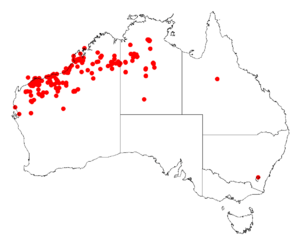Salt wattle facts for kids
Quick facts for kids Salt wattle |
|
|---|---|
| Scientific classification | |
| Genus: |
Acacia
|
| Species: |
ampliceps
|
 |
|
| Occurrence data from Australasian Virtual Herbarium | |
The Acacia ampliceps, also known as the Salt Wattle, is a type of shrub or small tree. It is part of the Acacia family. This plant grows naturally in the northwestern parts of Australia.
What is the Salt Wattle?
This bushy shrub or tree usually grows between 1.5 and 9 meters (about 5 to 30 feet) tall. It has smooth, hanging branches that are yellowish. Its thin, light green leaves, called phyllodes, also hang down. These leaves are long and narrow, measuring about 7 to 25 centimeters (3 to 10 inches) long. They are also 7 to 30 millimeters (about 0.3 to 1.2 inches) wide. The Salt Wattle blooms from May to August. During this time, it produces lovely cream-colored flowers.
How Was Salt Wattle Named?
A botanist named Bruce Maslin first officially described this plant in 1974. He wrote about it in a scientific paper called Studies in the genus Acacia Miscellaneous new phyllodinous species. This paper was published in a journal called Nuytsia.
Later, in 2003, another botanist, Leslie Pedley, changed its name to Racosperma ampliceps. But then, in 2006, it was moved back to the Acacia family. So, its official name is still Acacia ampliceps.
Where Does Salt Wattle Grow?
The Salt Wattle is found only in certain areas of Australia. It grows in the Northern Territory and in the Kimberley and Pilbara regions of Western Australia. You can often find it near rivers and in floodplains. It also grows on sandy coastal dunes and in salty flat areas. It prefers sandy soils.

